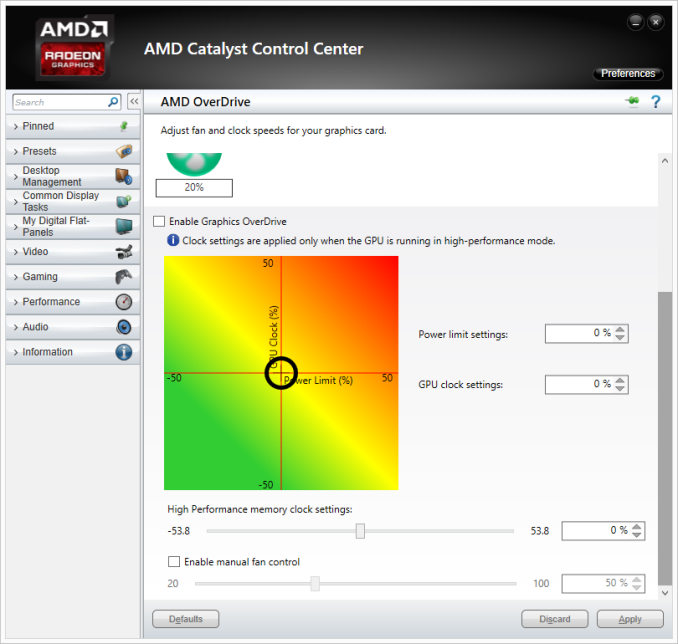Sapphire Radeon R9 290 Tri-X OC Review: Our First Custom Cooled 290
by Ryan Smith on December 24, 2013 3:45 PM EST- Posted in
- GPUs
- AMD
- Radeon
- Sapphire
- Radeon 200
290 Tri-X OC Thermal Management
Before jumping into our benchmarks, due to the significant focus we’re placing on cooling and noise for the 290 Tri-X OC (amidst the reference 290’s weaknesses) we also wanted to spend a moment discussing the card’s thermal management algorithms.
With the 290 series AMD introduced their next generation PowerTune technology, which allows for thermal management based on temperatures, power consumption, and now fan speeds. For the reference 290X in particular this was especially important as AMD used this functionality to keep fan speed noises in check despite the heavy thermal load Hawaii placed on the cooler. At the time we had assumed that everyone would use this technology even if they used different coolers, but as it turns out this isn’t the case.
For the 290 Tri-X OC Sapphire has reverted to traditional power and temperature based throttling, opting not to use the functionality of next generation PowerTune. This means that the 290 Tri-X OC does not offer the ability to throttle based on fan speeds, nor does it offer the ability to adjust the temperature it throttles at, instead throttling at Hawaii’s TjMax. This implementation caught us off guard at first since we had expected everyone to use next generation PowerTune, however as it turns out this is something that board partners get to decide for themselves on their customized cards.
Sapphire for their part has told us that based on the ample cooling performance of the Tri-X cooler that they've opted to use a traditional thermal management implementation in order to better sustain performance. Though we can’t readily test Sapphire’s statements about sustainability, we certainly can’t argue against Sapphire’s statement on the performance of their cooler. We’ll see the full breakdown in our benchmark section, but they are having absolutely no problem balancing noise and temperatures right now without next generation PowerTune.
Realistically we wouldn’t be surprised if this was also chosen because the Tri-X cooler predates the 290 series – and hence it wasn’t necessarily designed to work well with next generation PowerTune – but that’s just speculation on our part. To that end it would have been interesting to see a full next generation PowerTune implementation on this card, however it’s really just an intellectual curiosity. Out of the box the 290 Tri-X OC works just fine with a traditional thermal management implementation.
The Test
| CPU: | Intel Core i7-4960X @ 4.2GHz |
| Motherboard: | ASRock Fatal1ty X79 Professional |
| Power Supply: | Corsair AX1200i |
| Hard Disk: | Samsung SSD 840 EVO (750GB) |
| Memory: | G.Skill RipjawZ DDR3-1866 4 x 8GB (9-10-9-26) |
| Case: | NZXT Phantom 630 Windowed Edition |
| Monitor: | Asus PQ321 |
| Video Cards: |
AMD Radeon R9 290X AMD Radeon R9 290 XFX Radeon R9 280X Double Dissipation Asus Radeon R9 280X DirectCU II TOP Sapphire Radeon R9 280X Toxic AMD Radeon HD 7970 GHz Edition AMD Radeon HD 7970 NVIDIA GeForce GTX 770 NVIDIA GeForce GTX 780 NVIDIA GeForce GTX 780 Ti |
| Video Drivers: |
NVIDIA Release 331.93 AMD Catalyst 13.11 Beta v8 AMD Catalyst 13.11 Beta v9.5 |
| OS: | Windows 8.1 Pro |











119 Comments
View All Comments
asH98 - Tuesday, December 24, 2013 - link
I find it amazing how short sighted this writer is. It is obvious to anyone building a system AMD's 290 reference card gives the builder an opportunity to choose her/his GPU options, while allowing 290 suppliers an opportunity to make a few dollars and keep prices low - if the writer cant see something so obvious should I trust his articles? -blanarahul - Tuesday, December 24, 2013 - link
Please rewrite your thoughts using clearer sentences.blanarahul - Tuesday, December 24, 2013 - link
And proper punctuation.RaistlinZ - Tuesday, December 24, 2013 - link
I have absolutely no idea what point you're trying to make.Sunburn74 - Wednesday, December 25, 2013 - link
I too am completely lost as to your point.asH98 - Thursday, December 26, 2013 - link
The 290 reference card with fan allows me my choice of cooling options, or perhaps a choice of AIB solutions -this it is still cheaper relative to comparable offerings vs performance - everyone wins !!All the bitching and moaning about noise is BS - the reference fan was always to keep prices low and allow options to builders, while AIB suppliers made a few dollars - ...!!
firewall597 - Thursday, December 26, 2013 - link
I like how you automatically assume that everyone should be builders willing to take their GPU apart for aftermarket solutions.asH98 - Thursday, December 26, 2013 - link
- if you're not a builder prices are still low via AIB's, and their solutions !!sparkuss - Tuesday, December 24, 2013 - link
Just a quick double check. This is a pure reference board with no new components or change in location?I want to double confirm that I could buy this GPU now and be ready for some new Water Blocks for reference R290 when they become available (the WBs)?
Thanks
Ryan Smith - Tuesday, December 24, 2013 - link
Correct. Pure reference board with identical components and component positions, right down to the AMD logo.http://images.anandtech.com/doci/7601/S290_TriX_PC...